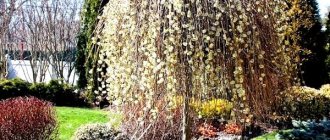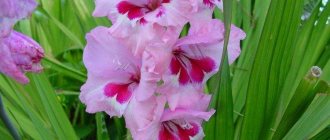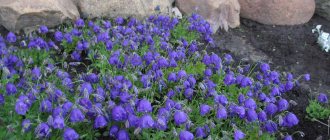Common hawthorn. Family: Pink. Its other names: prickly hawthorn, smoothed hawthorn, “lady” tree. In its natural habitat it is found mainly on the North American continent and in European countries.
In nature, this unpretentious plant settles on the edges of mixed forests. Hawthorn loves when the soil is dominated by clay.
Its name translates as “strong”. Probably because the plant's lifespan is several hundred years. But maybe the reason is the special strength of the wood.
Also, the name hawthorn could come from the word “boyarynya” or “hawthorn”. There is a beautiful legend telling about a beautiful girl wearing a wreath of blooming hawthorn on her head.
Popular varieties and types of hawthorn
Common hawthorn, also known as thorny hawthorn (Crataegus laevigata) . A tree or large spreading shrub, up to 4-5 m high. The shoots are numerous, hard, covered with sharp long thorns. The flowers are simple, white, rather large.
Description of hawthorn varieties of this type
"Gireoudii" is a small variegated tree on a trunk or bush. Young leaves are pink. Snow-white bloom. Since the decorative value of the variety lies in the foliage, the plant can be regularly trimmed to any height to maintain a beautiful shape.
Pink hawthorn 'Rosea Flore Pleno' and 'Alba Plena' with numerous white or soft pink small double flowers.
'Crimson Cloud' has showy red-pink simple flowers with a white spot at the base of the petals.
Single-petaled hawthorn (Crataegus monogyna) . It is characterized by shorter spines, elongated, strongly lobed leaves and a height of 3-6 meters. Some varieties have no spines. The crown is dense and dense. Variations of this species are highly decorative and have different crown shapes, which can be weeping or pyramidal.
The flowers are simple or double, pink, crimson, white, less often bicolor. There is also a variegated group and a magnificent variety that blooms throughout the summer months.
Among the noted varieties of hawthorn, the following are popular:
- Variegata group with variegated white-green or cream-green leaves;
— “Stricta” is a tree with a narrow, pyramidal growth habit and white flowering;
— “Compact” group — dwarf slowly growing bushes or trees with a spherical crown with a diameter of less than 1 meter, mainly on a trunk;
— pink decorative hawthorn “Rose” with dark pink petals on top and a white center;
One of the most ornamental shrubs is the intraspecific hybrid of hawthorn - Crataegus x media and its varieties:
- magnificent double hawthorn “Pauli Scarlet” with soft pink flowers that abundantly cover the shoots of a low tree;
- "Rubra Plena" - red-pink flowers have a lighter shade of petals on the underside, which gives a more interesting color effect.
Also popular among gardeners are the Dzungarian hawthorn with large and unusual black fruits, the red-fruited Arnold hawthorn (Crataegus arnoldiana) and the yellow hawthorn of the “Aurea” group.
Wind protection and site zoning
gardeninacity.wordpress.com
Hawthorn is a lifesaver for a novice gardener. Its unpretentiousness will play into your hands if you want to protect your site or a separate corner of it from bad weather and wind. It fits harmoniously into almost any garden composition, especially for those that require a dull background.
Hawthorn can also become a kind of “screen” that protects from prying eyes what the owners of the plot would like to hide. Whether it’s outbuildings, a not-so-decorative fence or a secluded gazebo - all of this can easily be hidden behind a spreading hawthorn.
Caring for hawthorn in open ground
Along with its decorative qualities, the crop is distinguished by its hardiness, so growing and caring for hawthorn will not be a problem. It is enough to irrigate the plantings once a month or 2-3 times during the dry season. A bucket is enough for one bush.
You might be interested to know what flowers are planted in spring
After irrigation, loosen the soil so that a crust does not form, preventing oxygen from reaching the roots. In the spring, before flowering, they feed with rotted mullein, diluted in water in a ratio of 1:10. Fertilizer is enough for the entire growing season and fruiting.
What is the difference between black hawthorn and red one: comparison of beneficial properties
There have been no special studies regarding the medicinal properties of black hawthorn compared to red hawthorn. You can find recommendations to use only the pentapistillate species as a remedy. But both red and black hawthorns are moderately poisonous.
No superiority of black over red or vice versa was noted. One can only assume that black fruits better relieve inflammation in the gastrointestinal tract and improve intestinal function due to the higher content of plant pigments anthocyanins in the peel. But red berries also contain anthocyanins, although in smaller quantities.
Hawthorn pruning
Sanitary and formative pruning of hawthorn is carried out in the spring, before growth begins. It is not recommended to radically shorten the shoots, as this will affect the flowering of the current season. But if flowering is not the main thing for you, then using figured cutting you can create beautiful topiary figures from trees.
Rosea Flore Pleno
Remove root shoots, damaged and dry branches. To obtain a low bush form, trim the shoots by 2-3 cm every year, maintaining the desired height. The shoots of young hawthorn hedge seedlings are shortened annually for 3-4 years by half their growth until the hedge reaches the required height. Then only corrective pruning of the hawthorn is needed in the summer after flowering.
Properties of culture. Practical use
Common juniper Hibernika: description and varieties
Thanks to its thorns and dense crown, hawthorn is used as a hedge. The decorative properties of the shrub allow it to be used as landscaping in parks and squares. The tree looks great in group and single plantings. Hawthorn is often used in green construction. The tree also has soil protection value in mountainous areas. In some cases, it is used as a rootstock for some fruit trees.
Interesting! In addition to the fact that the shrub is an excellent honey plant, a decoction can be made from its parts to dye fabric red.
Wood is of particular value. It is used for the manufacture of various tools (shanks for shovels, percussion instruments, etc.), and thanks to its viscous beautiful texture, it serves as a raw material for carpentry, toys and dishes. Juices, jams, marmalade, marmalade, compotes and other products are made from the fruits of the plant.
The fruits and flowers of the shrub are widely used in medicine. Medicines prepared from hawthorn help with shortness of breath, dizziness, and insomnia. Preparations useful for headaches, vascular spasms, atherosclerosis, and hypertension are made from the fruits of the bush. Hawthorn can purify the blood.
Blood-red hawthorn is especially effective in this regard. The fact is that the tissues of the bush contain plant pigments, flavonoids, plant glycosides, saponins and other compounds. Hawthorn fruits are rich in sugars, organic acids, vitamins (C, B, E), starch, pectins, carotene and microelements (calcium, iron, magnesium, etc.).
Decoction
The unofficial name of hawthorn, which people called it, is “bread of the heart.” The explanation here is very simple - tinctures, extracts, decoctions made on the basis of this plant:
- improve heart function;
- strengthen the walls of blood vessels;
- reduce the excitability of the nervous system;
- stimulate blood circulation;
- help relieve stress and fatigue;
- normalize sleep.
Such drugs are especially useful for women during menopause and the elderly. The most effective medicines are those prepared from fresh flowers. Such drugs are prescribed to patients suffering from diabetes.
It is noteworthy that an extract from hawthorn fruit is one of the ingredients of cardiovalene. The drug has virtually no side effects, has a simulating effect on the heart, and reduces the amount of cholesterol in the blood.
After long-term use of hawthorn-based preparations:
- there is a significant improvement in the patient’s general well-being;
- blood pressure is normalized;
- headaches disappear
- dizziness and noise in the head and ears stop;
- blood cholesterol levels decrease;
- blood clotting improves.
According to modern experts in the field of traditional medicine, the use of hawthorn-based products is one of the best ways to prevent diseases of the cardiovascular and nervous systems. Under the influence of hawthorn, blood vessels dilate, have a diuretic effect, and accelerate recovery processes after serious illnesses. It is also assumed that hawthorn with black fruits is especially effective in the fight against atherosclerosis and tumor formations. This is explained by the fact that the fruits of the bush contain anthocyanins, which are capable of destroying free radicals in the human body.
It is important! Contraindications to taking drugs based on hawthorn are pregnancy and lactation. It is also forbidden to drink decoctions and tinctures on an empty stomach - only 30 minutes after eating
Since hawthorn can lower blood pressure, people with hypotension should take it with great caution. Do not take the drug for too long a time, as this may lead to depression of the heart rate.
The tree, and especially its flowers and fruits, has many beneficial properties and qualities. A wide variety of types and varieties of wood will allow the gardener to choose the most suitable option for him in accordance with his taste preferences and intended purpose.
0 0 votes
Article rating
Propagation of hawthorn by seeds
Obtaining young seedlings from seeds takes a very long time. For successful germination, planting material requires long-term cold stratification from 12 to 18 months.
You can reduce this time slightly by soaking the seeds overnight in warm water and then placing them in a damp mixture of peat and sand in a bag or plastic box. Before sowing, they are kept in a dark place for 3 months at a temperature of 15 °C, and then another 3 months at a temperature of 4 °C.
Other methods to speed up the germination process include scarifying the seed before sowing or fermenting it for several days in fruit pulp. Not quite mature seeds are best suited for sowing, which are sown immediately in open ground in late autumn or in the spring after stratification.
fruit bush
If we talk about hawthorn as a fruit and berry crop for use in cooking, then here it is not much different from others. Its berries can be used to prepare a wide variety of dishes - from jam and marshmallows to soups and alcoholic drinks. Teas and medicinal infusions are prepared from dried berries.
The taste of hawthorn depends not only on the degree of ripeness, but also on the specifics of each individual species. Generally speaking, the fruits of wild hawthorn are noticeably mealy and slightly astringent in taste. Berries collected from varietal plants are not so tart and contain more sugar.
Kvass with hawthorn. Rinse 500 g of hawthorn with a little water and place on low heat for 1-2 hours. After this, rub the berries through a sieve and dilute with water to the desired consistency. Let it brew a little, then strain and add 2 cups of honey or sugar and 30 g of yeast. Leave to ripen for 8-10 days.
Hawthorn jam. Pour 1 kg of washed and pitted hawthorn fruits with 500 g of sugar and leave for several hours. After the berries have released their juice, place the pan over low heat and cook, stirring constantly, until the contents thicken. Roll the finished jam into pre-sterilized jars.
- What berry goodies can you prepare for the winter?
In the summer, when the berries ripen in the garden, the main thing is not to miss the moment and make supplies for the cold autumn-winter months.
Propagation of hawthorn by cuttings
Unfortunately, this method does not give 100% results. For propagation, flexible semi-lignified shoot tips 15-20 cm long are cut off just below the node. The lower leaves are torn off.
The cut is dipped in root growth stimulating powder and buried in a mixture of perlite, sand and universal soil in a ratio of 1:1:2. Water the mixture well and cover the pot with a bag or plastic bottle. Monitor soil moisture and periodically ventilate the greenhouse.
Usually roots form after 20-30 days. When the seedling begins to form leaves, it can be transplanted into open ground. For the first 2 years, the hawthorn is covered with fallen leaves for the winter and watered regularly.
Diseases and pests of hawthorn
The disadvantage of the ornamental hawthorn shrub is its low resistance to a number of fungal and bacterial diseases and pests.
Common diseases include scab, powdery mildew caused by excess moisture and poor air circulation, rust and various types of leaf spot.
To prevent the development of diseases, it is recommended to treat plantings with special preparations twice a season in March and autumn. To prevent the spread of diseases, fallen leaves are collected and burned in the fall.
How to get rid of aphids using traditional methods can be read in this article
Hawthorn pests: aphids, caterpillars, leaf rollers, scale insects and the hawthorn butterfly, which lays eggs in inflorescences.
Pest Control
The fight will need to be carried out with hawthorn, scale insects and false scale insects, peelers, sawflies, weevils, lacewings, ringed cocoon moths, aphids that attack buds and leaves, and comma-shaped scale insects that attack the trunk and branches. Diseases of the crop are powdery mildew, rot and rust.
Before buds bloom, tree-like bushes should be sprayed with Bordeaux mixture - 3-5%. Branches affected by rust and bud mites are pruned in autumn and spring, and the crown and trunks are sprinkled with colloidal sulfur. After flowering is completed, spraying is repeated for heavily infected trees. The work is carried out while simultaneously spraying other fruit plants in the garden.
Forming a fence profile
The design of a green hedge begins in the second year after planting the hawthorn. Using scissors or pruning shears, cut off dry branches and those that protrude beyond the intended lines. In the future, the hedge is trimmed, adhering to the same height, so that it does not overgrow.
Growing a hawthorn hedge is a real art. Its design can take any shape, but it is important to take into account that trimmed bushes may not bloom or set fruit.
Trimming protruding shoots of hawthorn bushes
A classic hedge is made in a rectangular shape, without narrowing the crown, as with the natural growth of hawthorn bushes. Over time, it is exposed at the roots so that the lower part receives enough sunlight.
If you make a trapezoidal fence with a smoothly rounded top, it will look more natural. When forming it, the evenness of the edges is not adhered to, as is the geometric accuracy of the contour, but the design of the fence is somewhat more complicated.
Return to content
Advantages of a hedge
Hedges have long been common in all corners of the world. The huge demand for it is increasing every year, and all thanks to its relatively large number of advantages:
- Effective protection of property from illegal intrusion and prying eyes. Translated from Latin, “hawthorn” means strong. As you can see, the name of the hedge reflects the special strength of the bush and the rigidity of its branches. If you constantly trim the hawthorn crown, it will thicken, and the countless sharp thorns will make the green hedge inaccessible to uninvited guests and animals.
- Natural naturalness. Hawthorn greenery is not only pleasing to the eye, it can be used as a backdrop for other plants as it blends well with them, garden designs and buildings.
- Environmental Safety. The purity of the wood of the bush is beyond doubt; birds live inside it.
- Hawthorn hedges have excellent sound insulation properties. It makes the air cleaner because it prevents the penetration of dust and exhaust gases.
Hawthorn fence
- Small costs for material (seedlings and fertilizer, possibly trellises) and labor. Most often, hedges are grown by hand.
- Unpretentiousness to conditions. Hawthorn is resistant to frost and drought, it is not picky about the soil. Its shoots have been preserved for centuries.
- Long service life. If you care for your hedge, adhering to all the rules (watering, fertilizing, cutting and loosening the soil), it will last for many decades. There is a well-known hedge planted more than three centuries ago. It is located in the UK.
- Always in fashion. A living structure is not in danger of becoming obsolete; it will remain prestigious regardless of fashion trends. After all, land plots were decorated with it back in the days of Ancient Rome.
Another plant that is often used to build hedges is thuja seedlings. Thuja will make an excellent evergreen fence that will protect you from both noise and dust. When organizing flower beds or planting new seedlings of trees and bushes, we recommend using wood chips, which will allow you to avoid overgrowing the area with weeds. Read the details in our article at the link.
Return to content











